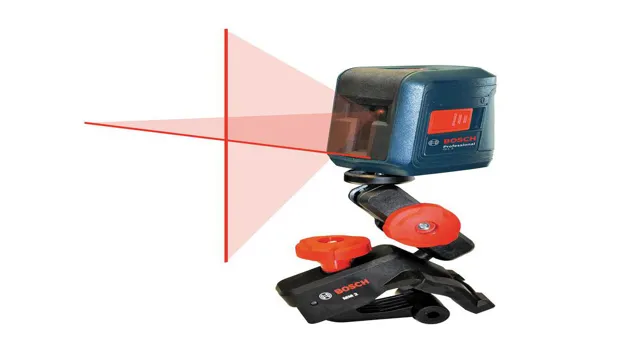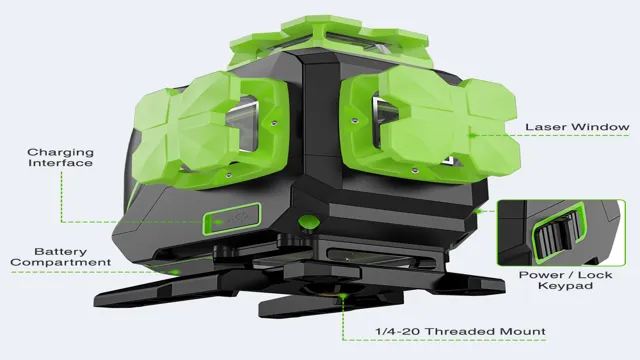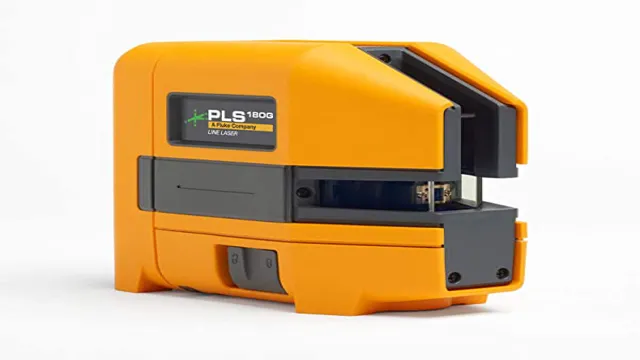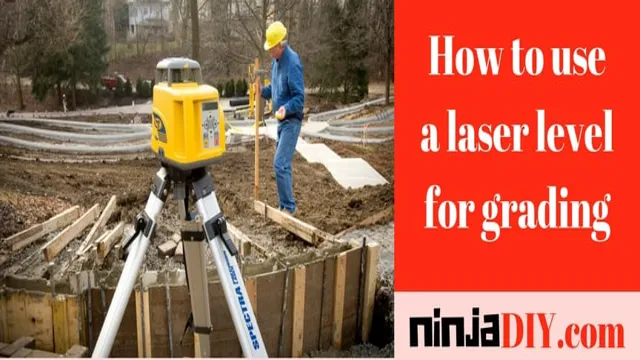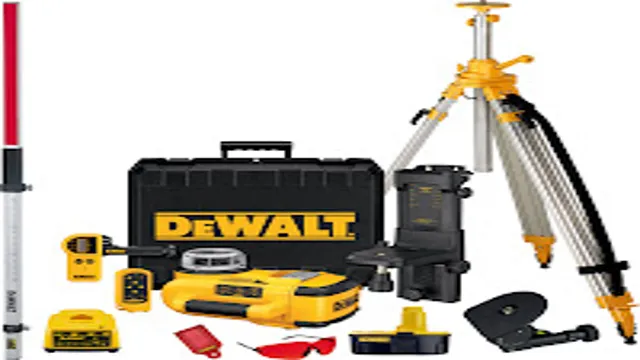How to Use a Laser Level for Drainage: Tips and Techniques for Accurate Slope Measurement

Drainage is a vital element in any construction project or outdoor landscaping project. Whether you are looking to create a beautiful garden with plants or just make sure your house is safe from flooding, proper drainage is key. One of the best ways to ensure proper drainage is by using a laser level.
A laser level for drainage is a useful tool that has become popular among builders, landscapers, and DIY enthusiasts. In this complete guide, we will explore how to use a laser level for drainage and everything you need to know to get started. We’ll cover the pros and cons of laser levels, the key features to look for when choosing a laser level, how to set up and use your laser level, and common mistakes to avoid.
By the end of this guide, you’ll be equipped with knowledge and skills to accurately measure your drainage and create a well-drained, functional landscape.
What is a Laser Level?
If you’re planning to install a drainage system on your property, using a laser level can make the task much easier. But what exactly is a laser level? Simply put, it’s a tool that uses a laser beam to create a perfectly level reference line. These levels come in various types, including dot, line, and rotary levels, each with its own unique functions.
Using a laser level for drainage ensures that the water will flow smoothly and prevent any stagnant water in the area. To use a laser level, you first need to set up the device, which involves finding a stable surface and adjusting the height of the laser level. Once you’ve set it up, turn on the laser beam and aim it at the target surface.
By following the beam, you’ll be able to ensure that the surface has a consistent slope and that water will flow in the right direction. With a little practice, you’ll soon get the hang of using a laser level for drainage and be able to achieve a professional looking result every time.
Definition and Basic Principles
A laser level is a leveling device that projects a laser beam onto a surface for alignment and positioning purposes. It is used for a variety of tasks, including construction, carpentry, and electrical work. The laser level works by emitting a beam of light that is straight and level and projects onto a surface in the form of a line or dot.
The device is also equipped with leveling mechanisms that allow for precise adjustments to ensure the accuracy of the laser beam. The main principle behind a laser level is the use of light and optics to create a straight, level line. This makes it easier to position and align objects with precision and accuracy.
The device is highly effective in reducing errors and saving time for both professionals and DIY enthusiasts. So, if you’re looking for a tool that can help you achieve accurate and efficient results, a laser level is definitely worth considering!

Types of Laser Levels for Drainage
A laser level is a tool that emits a laser beam to project a straight and level line onto the surface it is placed on. The beam is typically used as a guide for construction projects such as drainage systems, foundations, or floors. Laser levels for drainage are specifically designed to help ensure that the slope of the ground is correct to allow for proper water drainage.
There are several types of laser levels for drainage including rotary laser levels, line laser levels, and dot laser levels. Rotary laser levels are the most common and project a 360-degree beam of light that can be set to different angles to ensure the correct slope. Line laser levels project a straight line and are useful for smaller drainage projects.
Dot laser levels project multiple dots that create a level reference point for more precise leveling. When selecting a laser level for drainage, it’s important to consider factors such as range, accuracy, and durability. Some models have additional features such as a remote control or self-leveling capabilities.
Overall, a laser level can greatly improve the efficiency and accuracy of drainage projects, making it a valuable tool for both professionals and DIY enthusiasts alike.
Choosing the Best Laser Level for Drainage Work
If you’re looking to do drainage work, choosing the best laser level for the job can save you both time and effort. When selecting a laser level, consider factors such as accuracy, range, and durability. You want to ensure that the laser level is easy to use and provides accurate readings for the job at hand.
Depending on the size and scope of your project, you may want to consider a rotary laser level, which offers a longer range and can project a beam over a larger area. Regardless of which laser level you choose, make sure to use it properly by placing it on a level surface and checking the accuracy before beginning work. Using a laser level for drainage work can help ensure that your project is done correctly and efficiently the first time, saving you both time and money.
Factors to Consider
When it comes to drainage work, choosing the right laser level is crucial. One of the most important factors to consider is the accuracy level of the laser level. You want to make sure you’re able to get precise measurements, especially when it comes to grading and slope.
Another consideration is the range of the laser level. The range will depend on the size of the project, but it’s important to ensure the laser level can reach all necessary areas. You’ll also need to think about the durability of the laser level, as it’s likely to be used in tough and potentially wet conditions.
Finally, you’ll need to consider the ease of use of the laser level. Look for a model with clear instructions and intuitive controls to save time and frustration on the job. Ultimately, the best laser level for drainage work will depend on the specific needs of your project, but by considering these factors, you’ll be in a better position to make an informed decision.
Popular Brands and Models
When it comes to drainage work, laser levels play a crucial role in ensuring accurate and efficient results. With so many brands and models available in the market, it can be overwhelming to choose the best laser level for your needs. Some popular brands to consider include Bosch, Dewalt, and Topcon.
These brands offer versatile and durable laser levels that can handle a variety of drainage projects. In terms of models, the rotary laser level is a popular choice for drainage work as it offers a 360-degree coverage and high accuracy. Other important factors to consider when choosing a laser level for drainage work include the working range, visibility in different lighting conditions, and its ability to withstand harsh weather conditions.
By considering these factors and choosing a reliable brand and model, you can ensure successful and precise results in your drainage projects.
Preparing for Drainage Work with a Laser Level
When it comes to preparing for drainage work, using a laser level can be incredibly beneficial. A laser level can provide accurate and precise measurements of the land, ensuring that the drainage system is installed at the correct angle for optimal performance. To use a laser level for drainage work, start by setting it up on a tripod in the highest point of the area where the drainage will be installed.
Once the laser level is set up, turn it on and adjust it until the beam is level. Then, move the laser level around the area to mark the spots where the drainage system will be installed, ensuring that each spot is level with the others. Finally, take note of the measurements and use them to install the drainage system at the correct angle.
By using a laser level for drainage work, you can ensure that the job is done right the first time, saving yourself time and money in the long run.
Project Planning and Site Preparation
Preparing for drainage work can be an overwhelming task, but using a laser level can help streamline the process. A laser level is a handy tool that uses a laser beam to create a level reference point. By using a laser level, you can ensure that the project’s slope is consistent, allowing water to flow unobstructed.
Before starting, make sure that you have a clear plan in place. Determine the project’s scope and the materials you will need. It is also important to check local codes and obtain any necessary permits.
Once you have your plan and permits, you can start preparing the site. Clear the area of any debris and level the ground as much as possible. Then, mark the points where the drainage will be installed using wooden stakes.
Using a laser level, ensure that the stakes are level and at the ideal angle for proper drainage flow. By using a laser level, you can be sure that your drainage project will have a level slope and a successful result.
Calibrating your Laser Level Properly
Calibrating your laser level properly is essential when it comes to preparing for drainage work. This process ensures that the laser level is accurately measuring heights and distances, which is crucial when it comes to grading and leveling for proper drainage. One of the first steps is to make sure the level is placed on a stable surface.
You can then calibrate the level by using a calibration tool or by leveling it on a surface that has already been established as level. This ensures that your measurements are precise and accurate. By taking the time to calibrate your laser level, you’ll save time and money in the long run, as you won’t have to redo work that has been done incorrectly due to an improperly calibrated tool.
So take the time to get it right, and you’ll be rewarded with a job well done.
Using your Laser Level for Drainage Work
If you’re looking to ensure proper drainage for your property, a laser level can be an incredibly useful tool. To get started with using a laser level for drainage work, start by identifying the low points on your property where water tends to pool or collect. Then, set up your laser level to measure the slope of the land in these areas.
This will help you determine the minimum slope that’s required to ensure proper drainage. From there, you can begin grading the land to achieve the necessary slope. As you work, periodically check your progress with your laser level to ensure you’re on track.
Remember to always follow safety guidelines when working with a laser level, including wearing appropriate eye protection and keeping the laser level away from children and pets. With some patience and careful attention to detail, you can use your laser level to create a properly drained property that’s free from water buildup and flooding.
Setting Up your Laser Level on Site
When it comes to drainage work on site, utilizing a laser level can make the job a lot easier. But how exactly do you set up your laser level for this type of work? Start by selecting the appropriate spot for the level. Ideally, this spot should be flat and have a clear view of the entire work area.
Next, ensure that your laser level is set to the correct mode, in this case, the manual slope mode. This mode allows you to adjust the slope of the laser based on your specific needs. Once you are ready to begin, simply attach the laser level to the tripod and adjust the height to your liking.
Then, use the laser to mark the desired slope on the work area. By following these steps and ensuring that your laser level is properly calibrated, you’ll be able to tackle even the trickiest drainage work with ease. So, don’t hesitate to bring your laser level to your next job site and make your work more accurate and efficient.
Operating your Laser Level Correctly
When it comes to drainage work, a laser level can be an essential tool in ensuring proper pitch and slope. To use your laser level for this type of job, you’ll need to set it up at the highest point of the area you’re working on. Make sure it’s level using the built-in bubble vials, and then turn on the laser.
The laser will project a level line along the surface, allowing you to determine the necessary slope for proper drainage. From here, you can adjust the height of the laser as needed and mark where the slope should be. With the laser level, you can ensure a consistent and accurate slope, helping to prevent any water buildup or other issues.
Just be sure to follow all safety protocols and work with care to avoid any injury or damage to your tools.
Common Errors and How to Correct Them
Using a laser level for drainage work can make the job a lot easier, but it’s important to avoid common errors to achieve accurate results. The first thing to remember is to ensure that the laser is level before beginning. Even a slight tilt can cause discrepancies in measurements.
Additionally, make sure to set the laser at the appropriate height for the job at hand. Another common mistake is not taking into account the curvature of the earth. This can result in the laser being off-target, particularly when working on longer distances.
To correct this, use a tool called a grade rod to compensate for the curvature. Lastly, keep in mind that surfaces like water can reflect the laser and affect the accuracy of the measurements. Get the most out of your laser level by avoiding these common errors and achieving precise results for your drainage project.
Conclusion and Final Thoughts
In conclusion, using a laser level for drainage is a great way to ensure your project is level and properly sloped. Just like Batman needs his trusty utility belt, you too need a few key tools in your arsenal to get the job done right. With the help of a laser level, you can create a perfectly level surface that drains water away from your structure like a boss.
So, go forth and conquer your drainage project with confidence, and remember- always level up!”
FAQs
What is a laser level and why is it useful for drainage projects?
A laser level emits a highly accurate laser beam that can be used for precise measurements and leveling of surfaces. This is particularly useful for drainage projects that require accurate slope measurements to ensure proper water flow.
How do I select the right laser level for my drainage project?
Consider factors such as the size of the job site, the required accuracy, and the available budget. Choose a laser level with the appropriate range, accuracy, and features such as self-leveling and multiple beam settings.
How do I set up my laser level for a drainage project?
Follow the manufacturer’s instructions and ensure that the laser level is stable and level. Establish the desired slope, then adjust the laser level accordingly. Use a tripod for added stability and accuracy.
How do I interpret the readings from my laser level during a drainage project?
Read and record the measurements carefully and ensure that they are within the desired tolerances. Use the laser level to establish the slope and direction of the drainage system, and make adjustments as necessary.
What are some common mistakes to avoid when using a laser level for drainage?
Avoid setting up the laser level on unstable or uneven surfaces. Ensure that the laser beam is not obstructed by objects or debris. Double-check all measurements and calculations to ensure accuracy.
Can I use a laser level to check the final grade of a drainage project?
Yes, a laser level can be used to ensure that the final grade is consistent and at the desired slope. Use the laser level to measure the elevations of various points on the drainage system and make adjustments as necessary.
How do I maintain and store my laser level after use in a drainage project?
Follow the manufacturer’s instructions for cleaning and maintenance. Store the laser level in a dry and secure location, and protect it from dust, moisture, and extreme temperatures. Regularly calibrate the laser level to ensure accuracy.

